Mark Amery – 30 October, 2011
I don't need a male curator to make me feel part of these artworks' audience. The images of women I see often don't compute with those around me in reality. The art here looks to be confrontational in its engagement with viewers, and no more so than with men.
Wellington
Sarah Jane Parton, Bek Coogan, Gemma Syme, Emily Jolliffe, Erica Sklenars, Claire Harris and Natalie Ellen-Eliza.
Typical Girls
13 October - 17 December 2011
There’s something to get out of the way straight up with Typical Girls: a hairy man in the room, as it were. This exhibition of recent video work by women artists graduated from, or currently studying at Wellington’s Massey College of Creative Arts has been curated by a male Massey lecturer, Bryce Galloway. A man framing an exhibition that reacts to the way women are framed. And is now getting framed by a male critic.
Taking its title from a song by female punk band The Slits, Typical Girls smartly recognises the number of women artists coming through Wellington who are putting themselves in front of their cameras to provide in-your-face counteractions to popular-cultural stereotypes of women. And its true, I think, that while men appear to be getting to loosen their ties more and more often, young women continue to be under pressure (more on those two words later) as to how they should behave and look.
I don’t need a male curator to make me feel part of these artworks’ audience. The images of women I see often don’t compute with those around me in reality. The art here looks to be confrontational in its engagement with viewers, and no more so than with men. Many works talk to the tendency online for relationships to get treated as a consumer interaction. The artists in Typical Girls employ themselves as subject to counteract a media that treats women as object.
Yet there are no brow-beating polemics here. Like Galloway’s own practice, it is an active humorous art. One interested with equal doses of angst and apathy in the complexities of social interaction. In the act of looking and being looked at. The artists create actions that respond to the intimate interactions we have through our computer screens.
Galloway is reactor rather than creator of any movement. The spark comes from the artists, acknowledged by the inclusion in the catalogue of a transcript of a lively and hilarious 2007 Radio New Zealand interview between Bek Coogan and Slits flounder Ari Up. Also included is an excellent essay by Rebecca Rice.
Rather than leaving vital, socially relevant work on the artist-run fringes Typical Girls brings it into the establishment. As public galleries should be doing far more, the exhibition recognises art that is very much of this public time and place. It recognises a lively local artistic community of interactions.
The dynamic between artists and curator is nicely summed up by the irony-soaked charge of the title and contents of a work by Natalie Ellen-Eliza. In I love you, Bryce we watch Ellen-Eliza, with deadpan calm, clip her pubic hair and carefully adhere it to her face to create a beard. No bunny suits and Hefner styled dressing gown for Galloway here. The smiling artists are giving the fingers to “the man”.
The works are often light and seemingly casual in action, but carry weight and impact. This is not big work, and it’s nice to have a curator who doesn’t pretend it is. “No room for dumb jokes within fine art,” writes Galloway in the introduction. “Ha! And Ha again!”
Like punk did for music, the art revels in an age when through video artists can be more immediate, direct and less turgid. It reacts against the glossy overworked and stylised way film and television presents us on screen.
In this context its plainness is often winningly disarming. Rather than suck a popsicle long and hard Erica Sklenars gives us 19:18 minutes of it melting under her arm, leaving a sticky residue, like sweat soaking into her vest. There are after all two main ways to take someone’s temperature.
Like Ellen-Eliza, Sklenars makes her countenance as matter of fact as possible as she endures a sticky, freezing cold test (a nice counter to all those men in the ‘70s cutting themselves up and applying leaches). I find her older hair plucking video far duller and more predictable by comparison, but perhaps here is one instance where a work appeals more to the female viewer.
Where the work is theatrical it is so in a direct self-controlled way. A performance like Claire Harris’s in Born in Gore revs up like a singer going into the temporary swagger of the performance of a song. This terrific work sees Harris scream her lungs out in a Bronte-esque white night gown with bagpiper in tow on the Wuthering Heights beyond Wellington. Rock n roll primal scream therapy in reaction to growing up with a cultural landscape full of female characters made mad by love.
As well as punk it is often - apathetically, aggressively, and dressed down aesthetically - grunge. The visual equivalent of a gob from the stage - an echo of ‘70s video art’s breaking of the fourth wall with the action of the body. In Emily Jolliffe’s Pet Screensaver the artist in red lipstick licks the computer screen as if it were coated in sugar - a rather effective antidote to internet voyeurism.
In Nexted Ellen-Eliza documents her ever-changing, ordinary appearance as she is ‘nexted’ through webcam Russian roulette (Chatroulette). It’s an overtly banal but loaded performance, where the subject appears to be trying their best to be the viewer not the viewed. Like Waiting For Godot you keep waiting for something to happen and it never does, underlining the meaningless of much internet grazing and our quick online judgement of things based on signifiers on their surfaces.
In Gemma Syme’s Naive Melody (Under Pressure) the screen is split into two, the artist, headphones on singing along with the David Bowie and Freddy Mercury parts of Under Pressure respectively before her webcam. The song’s hooky charm has always been the rhythmic musical containment of the singers’ overwrought and overdramatic stylings. They warble emotionally loaded phrases until they become abstracted blubber. In Syme’s ordinary, shaky voice the operatic takes on far more real, ordinary emotional implications. As if she might be a student on the verge of a pre-exam crash. Both Syme and Ellen-Eliza’s works are painfully poignant to watch.
Given the work’s engagement with the computer as current mode of delivery it’s a nice touch that most of the work here is displayed on computers (the skull-like old iMacs). Even better would be for the exhibition to have a long life on line.
The camera is the documenter of actions, or is embedded in the performances in themselves as webcam. The exception is Sarah Jane Parton who in Bright Light she plays with the vocabulary of the music video. Turning like a music box dancer, a fully pregnant Parton undertakes meditative breathing exercises on an exercise bouncer, wrapped like an Easter egg ready for delivery. In terms of punk, Parton’s play with lighting, imagery and costumery has all the richness and melancholy of Siouxie Sioux in her Hong Kong Garden.
As a contained, humming cultural site Wellington is strong for interplay across different arts disciplines. While Parton works in both contexts of gallery and music video, Bek Coogan like Galloway is both rock musician and artist. In Hooves in the Dirt she represents her butch star sign Taurus. Mashing golden high-heeled boots into a lump of clay in Wellington’s Willis Street like a bull in mud, she is surrounded by a constant stream of passersby in duller footwear. It’s an earthy tenacious artist intervention into the streetscape - a kind of urban pottery - which the camera shows the public going out of its way to avoid. One person’s pile of mud is another’s precious pot.
If there’s anything there could be more of here it’s what Coogan expresses in her interview with Ari Up: “I’m not the only one who likes to wear her underpants on the outside of my tights and wow, yeah, my hair’s incredibly knotty and messy”. Which is to say that, despite Jolliffe’s screen licking, Coogan’s stomping and Harris’s screaming, the show could be even louder, more exuberant, uninhibited, and out-there theatrical in a way (as epitomised most popularly by the Real Hot Bitches) Wellington does so well.
Mark Amery
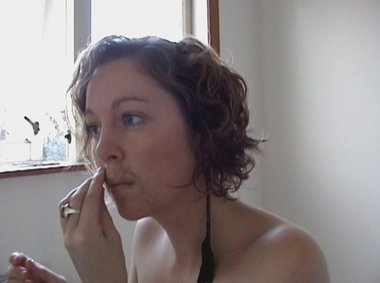
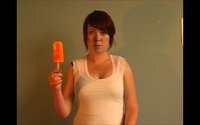
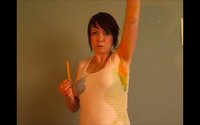
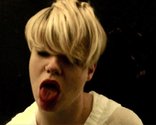


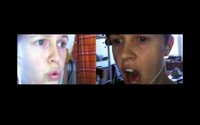
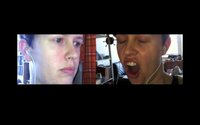
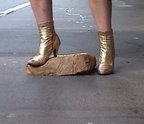
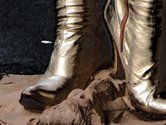
 Advertising in this column
Advertising in this column Two Rooms presents a program of residencies and projects
Two Rooms presents a program of residencies and projects



This Discussion has 0 comments.
Comment
Participate
Register to Participate.
Sign in
Sign in to an existing account.